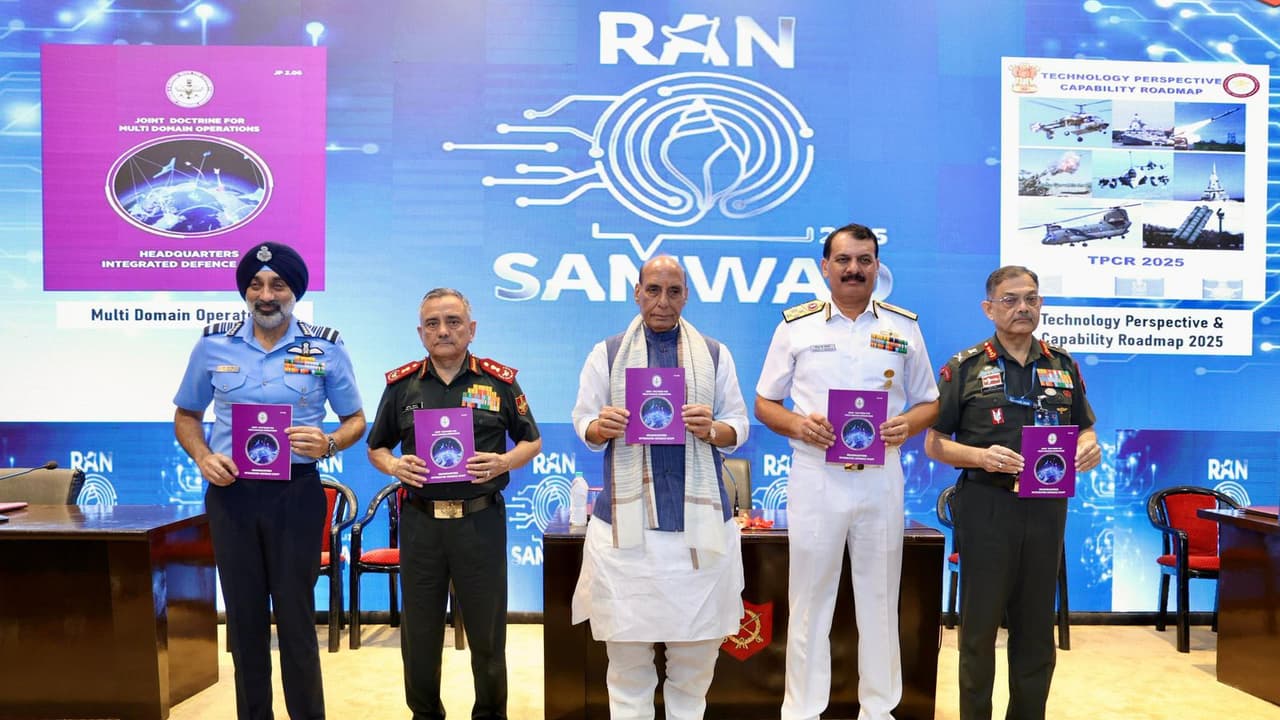India unveils its Multi-Domain Operations (MDO) doctrine at Ran Samvad 2025, integrating land, sea, air, cyber, space, and cognitive domains. The approach aims for synchronized military and national-level response to evolving security challenges.
Mhow: In light of India’s evolving security challenges, unpredictable neighbours, and the changing character of warfare driven by artificial intelligence, machine learning-enabled autonomous systems, and manned-unmanned teaming, a collaborative and integrated approach – ‘Multi-Domain Operations’ (MDO), has become imperative and also the need of the hour. Encompassing all six domains – land, sea, air, cyber, space, and cognitive, the MDO is now essential to gain a decisive advantage over adversaries in any domain at any point of time.
During a two-day event Ran Samvad 2025 at Army War College, Mhow in Madhya Pradesh, the defence minister, Rajnath Singh has released a number of doctrines, including one such on “Multi Domain Operations”, wherein the chief of defence staff, General Anil Chauhan, Indian Navy chief Admiral Dinesh K Tripathi, Indian Air Force chief ACM AP Singh and Indian Army vice chief Lt Gen PP Singh were also present.
The doctrine, MDO, conceptualizes how the three Services will organize, plan and fight, to defeat the adversary in any domain, at any level of war.
Scroll to load tweet…
Why MDO Is The Need Of The Hour
The aim of the doctrine, MDO, is to integrate and synchronise actions across all domains, in sync with multiple military as well as non-military partners. It is unlike joint operations that mainly coordinate military efforts of the armed forces.
As per Gen Anil Chauhan, “the MDO construct has the potential to create a resilient, responsive and agile force structure, capable of leveraging significantly augmented military power that actively accompanies the warfighter into the Tactical Battle Area while empowering the decision makers in the operation centres.”
Scroll to load tweet…
As we all are aware that the adversary has the capability to unleash actions across multiple fronts simultaneously and often below the traditional threshold of armed conflict, conventional defence strategies reveal critical vulnerabilities that can be readily exploited by the adversary.
This necessitates a fresh, comprehensive approach to security that transcends outdated methodologies and offers robust solutions to these complex challenges. This is one of the reasons why the MDO should be a connected, collaborative and interdependent aggregate rather than individual entities.
Fusing innovative structures and technologies to counter kinetic, non-kinetic and cross-domain threats, the MDO amplifies deterrence by presenting adversaries with simultaneous challenges across all six domains.
Structures and Implementation of the MDO
The joint doctrine on multi-domain operations mentioned that the armed forces need to play a ‘lead role’ not only in execution of actual operations but also in planning and coordination of these activities at the national level. The integration of Services is a sine qua non.
Since it is a ‘Whole of Nation Approach’ (WONA), other than the armed forces, everyone, including the paramilitary forces, state police, government and non-government organizations has a role to play, as part of overall ‘war waging effort’.
Effective pursuance of MDO requires the decision loops of all other government security related resource providers to keep pace with the military’s decision cycle. The supporting agencies would need to be fully integrated to support the lead agency to the greatest extent feasible.
The information operations need integrated, mutually reinforcing and compelling narrative to gain psychological ascendancy over the adversary war fighter at all levels of war.
